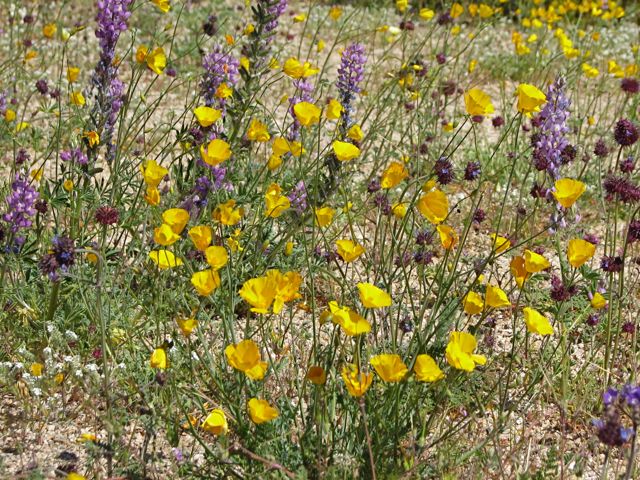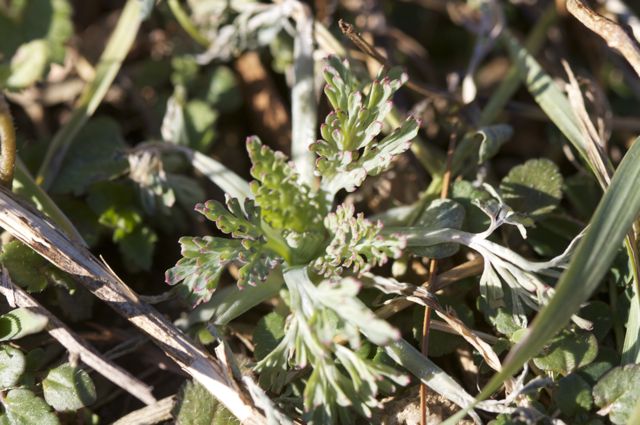
Giant Squill (Scilla peruviana)
Last year while traveling in England I ran across this beautiful Giant Squill (Scilla peruviana) in Merriments Nursery in Sussex. I was struck by the broad leaves and thick flower head — unlike any Scilla I had ever seen. Well the tropical foliage should have been my first clue but when I was filling out my Brent and Becky’s bulb order for the fall I saw them listed and quickly ordered 5 (the bulbs are $4 apiece). It was not until I actually got around to planting them that I realized that these are mediterranean plants (think Spain, Portugal, and Italy). Zone 7 is really pushing the edge for these plants.
It was during Christmas week that I saw them edging their way out of the soil before any other bulb. My guess is that this is why they might have trouble growing here. If they are really that anxious to be flowering, we are likely to have a collision with the weather gods. We are still two weeks away from the coldest days of winter so I will try to keep them mulched on the really cold nights. So far they have handled 13 degrees without apparent damage.

Scilla peruviana emerging
Wicked Gardens
Amy Stewart has a wickedly funny video that she shares on her recent post at Garden Rant. She has written a book on poisonous plants and with the help of her film industry brother has crafted a fun video that gets the point across. Highly recommended!
I was reminded of our arrival at our new country house where the people next door had a dead cow in the front yard. Apparently the cow had gotten loose and was eating the bushes in the front yard and it was probably the Yew bushes that did the cow in… Always makes you wonder who determined which plants are poisonous to humans and how they figured that out.
Christmas Trees Redux
Looking back at the Christmas tree post on January 4th it seemed like a good idea to see if I could track back and see where all the still living Christmas trees have ended up. I know that some died immediately and others just didn’t make it in this area. For instance there was a beautiful Fraser Fir that lasted for about 5-6 years and then one year just up and died. Anyway I did a head count today and there are still 8 other ex-Christmas trees hanging on. The list begins with a large White Pine that was a beautiful speciment until June of this year when we had a wind shear (mini-twister) come across our property. It took out three large 30 year-old apple trees, the top of a 50 foot high Tulip Poplar, a number of Black Cherries in the woods, and decapitated two very large White Pines including this one.

Decapitated White Pine
The third Christmas tree was a Colorado Spruce that I planted near the road. Because of its slow growth it got surrounded by a grove of Bigtooth Aspens and it’s definitely on the scraggly side.

Colorado Spruce
The next one in order was a Douglas Fir which grew well for a number of years in very poor soil and then lost the leader. My guess is bagworm, but it’s hard to recall now. It is finally starting to show some new leader growth so I think we will let it keep going.

Douglas Fir with dead top leader
Then we come to another White Pine behind the garage. This one is looking really nice. Truth in advertising compells me to mention that it also sits within spitting distance of the septic field so that could explain it’s vigorous growth.

White Pine (Pinus strobus)
Then we have another Douglas Fir near the woods in some of the best soil on the property and it too was defoliated at the top by bagworms. The remainder still continues to grow but it looks pretty strange.

Douglas Fir with dead top-leader
Next come two more White Pines next to the former Black Walnut site (and that’s another story to come). Each is growing fine but one needed to be limbed up to get rid of some vines. And then finally there is this year’s Douglas Fir newly planted at the bottom of the second pasture.

White Pine (Pinus strobus)

White Pine headed up

Douglas Fir (Pseudotsuga menziesii) planted in 2008
Snowdrops and Fallen Limbs
I got up this morning to find all of the trees laden with ice that had been deposited overnight

Japanese Maple heavy with ice
As pretty as that is, it came with a cost. The very same “first Christmas tree” that I mentioned on January 4th had three major scafold branches break off and a number related branches hit the deck too. The result is that the tree is even more looking like an artist has been pruning it. In fact it is the only self-pruning tree that we have on the property. It is remarkable that of the hundred or so White Pines that we have on our seven acres, this one tree has had by far the greatest number of branches break off, usually from ice but wind has managed the feat as well.

Several ice-covered branches off the big White Pine in the back yard
This being my birthday it was kind of a pain to haul those branches out of the yard (didn’t quite have the energy to take them all the way to the woods on this soggy day). But the reward for clearing them away was to discover two Snowdrops (Galanthus nivalis I think). These are the first real flowers to show themselves for 2009.

Snowdrops (Galanthus nivalis)
Finding the snowdrops stimulated me to take a wet misty walk around the yard to see what else was stirring. And, despite what has been generally cold, cloudy weather for the last week, I found many daffodil tips showing and the first of the crocus tips emerging as well. Now that was a nice birthday present indeed!

A long established clump of daffodils in the front yard
Return of the Poppies
Last year, after planting bed of daffodils on the hillside, I decided to overlay the daffodils with poppy seed. Now I have planted poppies many times over the years but I’ve not had much success since we began to get other things growing and mulching it all. The poppies seem to like bare earth to get going in. This time I went beyond a few packets. I ordered 2 “packs of poppies” from Wildseed Farms. And as a result we got the best stand of poppies that we’ve had in years. First the daffodils did their thing and then in June and July we were getting many beautiful poppies. And on one of the poppies I found the most beautiful little blue-eyed spider who somehow adapted to a flower that he/she had no reason to expect to be in Maryland.

Poppies flowering after the daffodils in June

Shirley Poppy

California Poppy

Spider with baby blue eyes
I grew up in Southern California and I’ve always had a soft spot for California Poppies. They volunteer along the roadsides and can appear with great abundance in the desert in a year with good rains. I took this picture in Joshua Tree National Monument last year.

California Poppies (Eschscholzia californica) in Joshua Tree National Monument
In addition to enjoying them last year one of my hopes was that they would self seed and come back again along with the daffodils. The weather was just warm enough over Christmas that I noticed the seedling poppies emerging. They are pretty hardy little plants so I’m hopeful that they will survive the freezing weather yet to come.

California Poppy seedling
And now from the Amazon
After yesterday’s post it seems only fair to give equal time to the other large flowering plant that contributes to our wintertime flower scene. Just like the Clivia, the Amazon Lily (Eucharis x grandiflora) is stimulated to flower by a spate of cool weather and typically produces flowers at least twice a year under our conditions. We leave it outside on a shady porch most of the year and bring it inside from late Fall to early Spring. We have never divided it, but it seems perfectly happy just somewhat potbound. With it’s glossy foliage it makes a spectacular impact when the beautiful white flowers come forth. Although there are quite a number of species in this genus, it seems likely that ours is the grandiflora hybrid as I’ve never seen any seeds.

Amazon Lily flower

The Amazon Lily sits next to a west facing window
A South African Treat
Every year about this time we have several weeks of flowering from a very pot bound Clivia miniata (Kaffir Lily). It sits in a north window during its flush of flowers and otherwise in the basement under lights for the winter. For the summertime it lives outside under a large Japanese Maple. The Clivia likes a certain amount of dryness between watering and the Maple is happy to accomodate by keeping most of the raindrops for itself. Usually we put the Clivia outside early enough that it will flower again in the Summer — it needs cool weather (not freezing) to stimulate flower growth. For several years I have been trying to get the courage to divide this beautiful plant which is one of the easiest-to-care-for and also most valuable semi-tropical plants that we have. I bought the original for $3.95 in a 1 gal container in California and brought it home on the airplane many years ago. It would be a small fortune to buy one this size locally. Another task is to take the easily havested seeds and have a go at growing these in the basement. And so the to-do list grows…

The brilliant orange flowers of Clivia miniata

The glossy green foliage is an excellent backdrop for the flowers
I always assumed that the Clivia came from India as I’ve seen them there and the name seemed synchronous with Robert Clive, the Englishman who spread empire to that part of the world. But, as it turns out, the genus was named in the 19th century for a Lady Clive, who later became a governess for Queen Victoria and all of the species are endemic to South Africa. Mostly we find the miniata in cultivation but the other species look like they would be interesting to try as well.
Signs of Spring
Well, it is a bit optimistic to be even looking Spring at the turn of the year, but I did see a few daffodils sticking their heads above ground when we had nearly 50 degrees after Christmas. Even more enchanting though was to see the buds of the Star Magnolia beginning to unwrap their little cat’s paws for the coming season. Unlike the Magnolia Soulangiana, which frequently gets the flowers blasted by cold in this area, the Magnolia Stellata is a reliable springtime perfomer. For us it sits in an extremely exposed position in our typical shale and yet seems to be growing year by year. I doubt that it will ever reach the dimensions of those at Longwood, but then it would probably overwhelm our yard if it did.

Magnolia stellata
